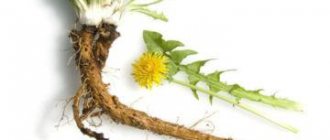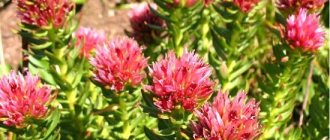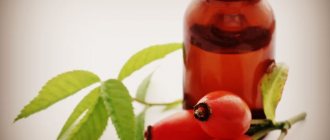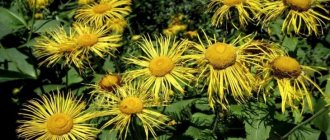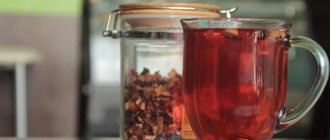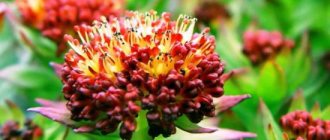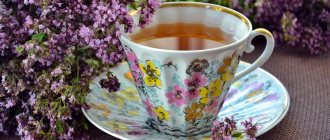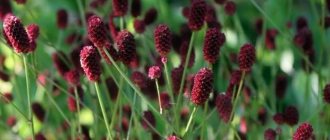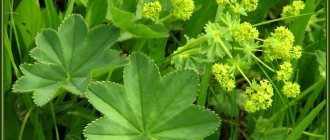The herbaceous perennial from the Madder family has several popular names - marina, marzana, crapp (krapp), petiolate madder or Georgian madder. Its Latin name (Rubia tinctorum) comes from the words rubber, which translates as “red”, and tinctorus – “dyeing”.
Madder root is considered a natural dye, which was used in the textile industry until the end of the 19th century. Today this plant is valued for its healing properties. You will learn about the medicinal properties and contraindications of the red root from this material.
What does madder look like?
Externally, the plant resembles St. John's wort: small flowers, elongated dense leaves curled into a ring around the stem, sharp small thorns. The stem of madder is thin, covered with rough bark. It can reach a height of one and a half meters.
The leaves are wide and dense, covered along the edges with sharp bristles. Madder blooms with small greenish-yellow flowers that resemble St. John's wort inflorescences. The powerful root system consists of the main root and numerous thin roots covered with brown bark.
Botanical description
Madder is a plant with a strong main root (called “krapp”) with thick rhizomes extending from it, covered with red-brown layered bark. Thin, highly branched, climbing, tetrahedral stems of the plant, planted along the ribs with prickly, curved needles, begin to grow in mid-May. Dense, hard, light green leaves of lanceolate or elliptical shape, seated along the edges and on the underside of the plate with frequent curved needles and collected in whorls of 2-6 pieces, reaching a length of 10 and a width of 3 cm. They can be sessile or attached to stem with a short, winged petiole. Small star-shaped yellow madder flowers with funnel-shaped corollas are collected in axillary or apical semi-umbrellas. Flowering begins in June and ends in August. Madder fruits, black drupes with juicy pulp up to 9 mm long, ripen from August to November in the first year of growth.
Madder root
This herb was first used in the textile industry. Dyes from madder root made it possible to dye various natural fabrics - silk, cotton, wool. Now the plant is used in folk and traditional medicine.
Traditional healers use this medicinal herb to prepare tinctures, decoctions and powders that provide relief from many serious diseases. In traditional medicine, the complex drug “Cystenal” has become widespread. The drops contain: extract from madder rhizome, magnesium salicylate, ethyl alcohol, eucalyptus, anise, phenicyl essential oils, olive and castor oil.
This medicine is prescribed for spasms and inflammation of the urinary canals, and urolithiasis. Take Cystenal five drops half an hour before meals. After conducting the necessary examinations and consulting with a doctor, a specialist may increase the dosage or extend the course of treatment. Taking drops during meals reduces acidity. Treatment lasts a month.
Madder collection and storage
For medicinal purposes, madder roots and rhizomes are harvested in the second or third year of the growing season, respectively: at the end of summer, from early August to late September, or in spring, from mid-March to mid-April. The roots are dug up, cleared of soil and, without washing, laid out in an open place under the sun to wilt. Then they are dry-cleaned from soil residues and dried in the shade or in a dark, dry room with good ventilation. If you decide to use an oven to dry the raw materials, the temperature in it should not exceed 45 ºC. Dry raw materials are placed in glass jars and sealed tightly. Madder roots can be stored for two years.
Chemical composition
The medicinal properties of madder roots are due to their rich chemical composition. They contain:
- tartaric, citric, malic organic acids;
- flavonoids;
- coumarins;
- ascorbic acid;
- anthraquinones;
- pectins;
- sugar;
- iridoids;
- B vitamins;
- essential oils containing phenols;
- proteins;
- tannins;
- carbohydrates;
- iron;
- potassium;
- natural dye;
- magnesium.
Description, reproduction and distribution area of madder
Perennial herbaceous plant of the madder family (Rubiceae), up to 2 m high.
The main root is powerful. Roots with thick creeping rhizomes extend from it. The roots and rhizomes are covered with reddish-brown exfoliating bark. The stem is thin, climbing, highly branched, tetrahedral, spiny and rough.
The leaves are light green, obovate, dense, woolly-spinous below, opposite, collected in whorls of 4-6 pieces, up to 9 cm long and up to 3 cm wide.
The flowers are small, yellowish-green, up to 1.5 cm in diameter, collected in few-flowered semi-umbrellas at the ends of the stems and branches.
The fruit is a juicy black drupe up to 5 mm long; their juice leaves almost indelible dark wine-red stains.
It blooms in June - September, the fruits ripen in August - November in the first year of life. Propagated by seeds and vegetatively.
Madder is widespread in the wild in Dagestan, Azerbaijan and other regions of the Caucasus, Crimea, and Central Asia. Grows in riverine tree and shrub thickets, on pebbles, steppe meadows, forest edges, in light pine forests, gardens, vineyards and along fences.
Madder is undemanding to the mechanical composition of soils: it grows on sand, loams and continuous soils of solonetzes.
Even in ancient times, artisans of the ancient Greeks, Romans, Egyptians and Persians highly valued madder root. Permanent red paint was obtained from it. In ancient times, madder was perhaps the only plant that was used to dye wool, silk and cotton fabrics. Madder root was well known in modern times. Textile workers were especially interested in it. The Free Economic Society of Russia established a high award - a gold medal and a cash prize for the development of resistant varieties of madder.
The medicinal properties of the plant have also been known since ancient times. Avicenna recommended preparing a drink from its roots in water sweetened with honey for the treatment of the sciatic nerve, paralysis, and loss of tissue sensitivity. The fruit was also used to make a drink with uxomed for an enlarged spleen. “It cleanses the liver and spleen and opens blockages in them,” wrote Avicenna.
Medicinal properties
Madder herb has powerful nephrolytic properties. The substances contained in this plant have a destructive effect on kidney stones and promote their elimination. Medicines made from the root of the plant relieve pain and spasms, normalize water-salt balance, and loosen phosphates and oxalates.
Traditional healers successfully cleanse the body of waste and toxins with herbs. Once in the stomach, madder preparations stimulate the production of gastric juice, have an anti-inflammatory effect, enhance the excretion of bile, and cleanse the body of toxins and waste.
In addition, this medicinal plant cleanses the blood, improves immunity and promotes cell renewal. Coumarins contained in the herb destroy malignant cells, preventing the appearance of tumors. Juice obtained from madder root is effective for rickets and abdominal pain. Decoctions and tinctures of madder remove excess salt from the body, helping in the fight against osteochondrosis and joint diseases. By supplementing the root with other ingredients, you can heal wounds and bruises and clear the skin of rashes.
Planting and caring for madder
- Flowering: from June to August.
- Planting: sowing seeds in the ground - in the second half of April.
- Lighting: bright sunlight.
- Soil: loose, humus-enriched, fertilized medium loamy soil.
- Watering: regular, moderate: the soil should be slightly moist all the time.
- Top dressing: in early spring, from the second season, nitrogen-phosphorus fertilizer is applied at the rate of 3 g per m².
- Reproduction: by seeds and division of rhizomes.
- Pests and diseases: not affected.
- Properties: medicinal plant, the preparations of which have antipyretic, antitussive, analgesic and anticonvulsant effects.
Read more about growing madder below.
Uses of madder
The medicinal properties and contraindications of the red root largely depend on the chosen dosage form. It has already been said that traditional healers prepare decoctions, tinctures, herbal teas and infusions from madder. Pharmacies offer to buy madder extract, which can be in the form of drops, powder or tablets.
In different forms, madder herb has different rules of use. More often in medicine, it is not the above-ground part of the plant that is used, but the root, the use of which differs from the greenery of the plant.
Instructions for use. Method and dosage. Recipes
Georgian madder can be used in the form of drops, tablets, tea, decoctions, etc. Ointment is suitable for external use. Self-medication is not advisable. How to use madder and how long the treatment course should last is decided by a doctor who knows the medicinal properties and contraindications of the medicinal plant.
Marzana decoctions
The decoction is used for joint diseases - gout, osteochondrosis, etc. Pour 2-3 tsp into boiling water (1-1.5 l). roots of the plant and boil the decoction for 10 minutes. The drink should steep for 15-20 minutes. The decoction should be taken warm before bed, ½ cup. The course of treatment is from 10 to 15 days.
Tinctures and infusions
Alcohol tincture of krap is used in the treatment of joints. It is taken for inflammatory processes of the genitourinary system. It is advisable to buy the drug at a pharmacy. To make the tincture yourself, you need to pour 2-3 tbsp. l. plants with a bottle of vodka. The product is infused for at least 10 days. The medicine is taken 1-2 times a day 20 minutes before meals. To prevent the tincture from causing addiction, the treatment course should not last longer than 15 days.
Infusions are used to treat cholelithiasis. This form of the drug is used in cases where the use of drugs containing alcohol is contraindicated for the patient. To prepare the infusion, you need to pour 1 tsp. roots with boiling water and leave for 8-10 hours. You need to take the medicine 1-2 tsp. three times a day 20 minutes before meals. The course lasts 20-25 days.
Herbal teas from specks
Madder for cystitis can be consumed in the form of herbal tea. In addition to marzana, the collection often includes birch leaves, chamomile and other medicinal plants. A bag of herbal tea should be filled with a glass of boiling water. The liquid is infused for 5-10 minutes. The drink should be taken in the evening an hour after meals. The treatment course lasts 3-4 weeks. The product is also used for annual prevention. In this case, the course is 2-3 weeks.
An effective medicinal form of the plant is madder extract in tablets.
Marzana extract
The plant extract is produced in the form of tablets, which need to be taken in 2 pieces. three times a day. The tablets must be dissolved in 200 ml of water and consumed before meals. Treatment lasts up to 30 days. If the doctor believes that the course needs to be repeated, this should be done in a month.
Madder in the form of drops
Madder (drops) improves kidney function and reduces swelling. The drug promotes the dissolution of calcium oxalates. Such substances are easily crushed and leave the human body. 3 times a day during meals, dissolve 15-20 drops of the medicine in 200 ml of boiled water. Treatment lasts 25-30 days.
Plant based ointment
The ointment is used for skin injuries or fractures. You can prepare the product at home. To do this, you need to grind 100 g of the dried root of the plant in a blender and mix it with the whites of 2 chicken eggs. The components are mixed or whipped until a homogeneous mass is formed.
You need to apply the product 2-3 times a day. You can apply a bandage to the treated area of skin to prevent staining your clothing. Do not apply ointment to open wounds and fractures.
madder is effective for urolithiasis, it dissolves and removes kidney stones formed
madder powder
Powder from the dried root of the plant is used for urolithiasis. During the period of admission, it is necessary to adhere to a diet, exclude from the diet smoked and fatty foods, foods containing a large amount of spices.
1 g of powder should be dissolved in 200 ml of boiled water and consumed 3 times a day 30 minutes before meals. The drug is taken in courses of 5-10 days with breaks of 2-3 weeks. The stones slowly dissolve and leave the patient's body safely.
Using the powder, you can get rid of the pain that occurs when stones pass. A pinch of the product should be placed on the tongue and washed down with half a glass of water.
How to take medications
Madder drops are used to remove calcium oxalates. They cause kidney stones. In accordance with the instructions, 20 drops of the drug are diluted in a glass of water. Take the medication before meals twice a day for a month.
Tablets from madder root should be taken 2-3 pieces, having first dissolved them in a glass of warm water. Treatment lasts from 20 days to a month, depending on the doctor’s recommendations.
Judging by people's reviews, after treatment with madder, if a person neglects contraindications, his chronic diseases may worsen. Before starting treatment, you must consult with a specialist and strictly follow the instructions for use of the drugs.
Growing madder
Landing
Madder is a heat-loving, moisture-loving plant that is demanding on the composition and fertility of the soil: its roots penetrate up to 35 cm deep, so the soil must be loose and structured, otherwise you can’t count on a good harvest. The best soil for madder is light or medium loamy, enriched with humus and well fertilized. It is advisable to sow madder after winter grains, early forage or vegetable industrial crops in an area that was previously fallow.
Before sowing, fall plowing is carried out on the site or the soil is dug up to the depth of a spade, filling each m² of land with 2 kg of humus or compost, then the site is harrowed and cultivated to a depth of 6-7 cm. The seed is treated before sowing with Granosan at the rate of 2 g of the drug per 1 kg of seeds.
- A convenient way to sow carrots in a mixed bed
In areas with a warm climate, madder seeds are sown directly into the ground in the second half of April, when the soil warms up to 6-8 ºC. Sowing is done to a depth of 4-5 cm, maintaining a row spacing of 45-60 cm. At a temperature of 10 ºC, seedlings can appear within two to three weeks, however, under unfavorable weather conditions, the process of seed germination can take 30-40 days. The most favorable temperature for the growth and development of madder is 23-25 ºC.
Madder is also grown from rhizomatous cuttings 6-8 cm long, which are planted at a distance of 10-15 cm from each other in furrows 8-10 cm deep cut with a cultivator. The filled furrows are rolled and watered.
Rules of care
Madder may bear fruit in the first year, but there will be few of them. Normal fruiting will begin at 2-3 years. Caring for madder consists of keeping the soil in the area moist and loose and removing weeds. During the season, it is necessary to loosen the soil 3-4 times, including between rows, and weed the area manually 1-2 times. In the fall, the plant should be earthed up, and from the second year of growing season in early spring, remove dead ground organs and add a nitrogen-phosphorus complex to the soil at the rate of 3 g of fertilizer per m².
Powder for kidney stones
Madder root for urolithiasis dissolves stones, promotes their painless removal, and reduces the accumulation of harmful phosphates and salts in the ducts. To prepare the medicine, you need to dilute 1 gram of plant root powder in 100 ml of water. Take the resulting product three times a day before meals.
When treating urolithiasis, you should undergo a full medical examination. Products that contain citric and oxalic acid are excluded from the patient's diet. Vitamin complexes must be prescribed.
pharmachologic effect
Rubia tinctorum is a remedy of plant origin. It has a diuretic and antispasmodic effect on the body. Under the influence of the drug, there is a decrease in the tone of smooth muscles, as well as an increase in its peristalsis. As a result, sand from the kidneys, as well as small stones, especially those containing calcium and magnesium phosphates, are painlessly expelled from the body.
Under the influence of the drug, urine is acidified, the severity of pain is reduced and the general condition of the body improves in people suffering from nephrourolithiasis. During therapy, the drugs gradually loosen and color the kidney stones red.
Treatment of cystitis
Due to the anti-inflammatory and bactericidal properties of madder root, the infusion is used for cystitis. To prepare it, fresh root of a small plant is poured with a glass of cold purified water, then infused for eight hours. The infused mixture is filtered, and the crushed root is poured again with 200 ml of boiling water. Strain the second part of the infusion after a quarter of an hour. Then mix both parts.
Divide the infusion into two servings and drink them throughout the day. This composition relieves inflammation, discomfort and pain.
Collection and preparation of medicinal raw materials
The raw materials used for medicinal purposes are the rhizomes and roots of madder. The best time for harvesting is the last 2-3 weeks of autumn. By this time the plant will completely wither. The root part of the grass is dug up. Then the roots should be cleared of clods of earth and only then can the grass be cut.
Some herbalists advise drying the plant unwashed. However, it is worth rinsing the roots in cold running water. Place the raw materials on a clean napkin and wait until completely dry. Before moving on to the next stage, you need to carefully examine the roots and get rid of damaged ones.
The roots are transferred to a dryer and dried at a temperature of no more than +55°C. Unless special equipment is used to dry raw materials, they should be stored in the shade rather than in direct sunlight.
It is permissible to collect in the same place once every 3-4 years. It is necessary to leave some of the rhizomes and not dig up young plants.
the plant has contraindications for use, which should be followed so as not to cause harm to health
Decoction for gout
How to brew madder root to remove salt deposits during padagre, normalize metabolism and improve the condition of joints? It is necessary to pour boiling water (300 ml) into one spoon of root powder and place the container on low heat. Bring the mixture to a boil and simmer for 10 minutes. Cool at room temperature and strain the broth.
Take 100 ml of decoction three times a day 40 minutes after meals. After just 10 days of taking the drug, the patient feels a decrease in joint pain and an increase in motor activity.
Baba Yaga
In Slavic mythology, the old forest sorceress. According to Slavic fairy tales, Baba Yaga lives in the forest, in a hut “on chicken legs.” This hut is depicted as standing either in the thicket of a forest (the center of another world), or at the edge of the forest, but then the entrance to it is from the forest, that is, from the world of death. The name “chicken legs” comes from “chicken”, that is, smoke-fuelled pillars, on which the Slavs placed a “death hut” - a small log house with the ashes of the deceased inside. This burial rite existed among the ancient Slavs until the 9th century.
Baba Yaga, inside such a hut, seemed to be like a living dead - she lay motionless and did not see the person who had come from the world of the living (the living do not see the dead, the dead do not see the living). She recognized his arrival by the smell - “it smells of the Russian spirit” (the smell of the living is unpleasant to the dead). The “chicken legs” of the hut can be simply animals or birds, and Baba Yaga herself has some features of an animal, and sometimes a bear or a goat lives in the hut instead. Baba Yaga is the mistress of time: she is served by the Red, White and Black riders, that is, morning, day and night.
A person who encounters Baba Yaga's hut on the border of the world of life and death, as a rule, heads to another world to free the captive princess. To do this, he must join the world of the dead. Usually he asks Baba Yaga to feed him, and she gives him food from the dead. There is another option - to be eaten by her and thus end up in the world of the dead. Having passed the tests in Baba Yaga's hut, a person finds himself belonging to both worlds at the same time, endowed with many magical qualities, subjugates various inhabitants of the world of the dead, defeats the terrible monsters inhabiting it, wins back a magical beauty from them and becomes king.
Infusion for prostatitis
Using herbal tea, you can relieve inflammation in the prostate gland. It is necessary to prepare dry madder root, calendula flowers, rose hips, shepherd's purse, wintergreen and angelica one teaspoon (teaspoon). Pour boiling water (300 ml) over one tablespoon (tablespoon) of the herbal mixture and let it brew for two hours. Strain the resulting product and divide into three doses. The healing infusion is taken before meals for 10 weeks.
Use in cosmetology
Thanks to its rejuvenating, antiseptic, whitening and cleansing properties, madder is used in cosmetology. This is an excellent assistant in the fight against inflammation, rashes, acne and the treatment of skin diseases. Using madder-based products, you can eliminate age spots and freckles.
In addition, the root of the plant can give the skin freshness, rejuvenate it, give it elasticity and a healthy appearance. Today you can buy ready-made creams, masks, lotions with the addition of this natural ingredient. If you wish, you can make your own skin care products.
To make your skin smooth, silky, soft and elastic, it is recommended to take a bath with a decoction of madder root. To prepare it, you need to boil two tablespoons (tablespoons) of dry root in two liters of water for 15 minutes. The resulting decoction is added to the bath. The procedure lasts no more than a quarter of an hour. The decoction can be used for washing and added to various masks. If desired, you can also use a pharmaceutical extract.
Helpful information
Madder dye is also successfully used in cosmetology:
- Anti-inflammatory properties help get rid of acne, cleanse the skin, relieve inflammation, and remove redness from sunburn. A lotion made from crushed momordica leaves will help remove inflammation and redness after mosquito bites.
- Whitening properties help lighten freckles, age spots, and even out skin tone.
- Toning properties will help rejuvenate the skin, restore its elasticity, and increase tone.
- To ensure that the skin of the whole body remains young and silky, it is recommended to take baths with decoctions.
You don't have to buy herbal tea for masks. It is enough to buy tablets with herbal extract and crush them in a mortar to a powder. It is better to use oatmeal or rye flour as a base for masks. For hair:
- Madder powder is mixed with henna and used to color hair. Depending on the ratio of dyes and the original hair color, you can get beautiful cool brown shades with a reddish tint. This coloring will not only change the shade of your hair, but also strengthen the hair follicles, making your hair manageable and shiny.
- A mixture of madder powder with ginger powder, white henna, lemon juice, hibiscus decoction or oak bark can be applied as a mask only to the hair roots.
On cat lovers' forums there is a lot of information on treating furry pets with drugs intended for humans. The instructions for using madder tablets to treat cats for urolithiasis are simple: take ¼ tablet, crush into powder and dilute in 25 ml of warm water.
Give at the rate of 1 ml per 1 kg of pet’s weight, in especially severe cases, increase the dosage by 2 times. It is best to give your cat water from a syringe without a needle. The course of treatment and dose must be agreed with your veterinarian.
Application in veterinary medicine
In our pets, diseases of the internal organs often cause metabolic disorders. Medicines containing madder root stop the development of pathologies of the urinary system. Our pets suffer from stones in the bladder and kidneys no less often than people. Madder will help remove them from the body.
Divide the madder tablet into four parts. Grind one quarter and dissolve in a spoon (table) of water. Place the resulting product into a syringe without a needle. Give your pet the medicine before meals twice a day. In case of advanced disease, the dosage is increased. Your pet should be examined by a veterinarian before using this product.
Overdose and interaction with other drugs
In case of an overdose of madder-based products, the patient may experience severe pain when emptying the bladder. Unpleasant sensations are associated with the passage of stones, which occurs gradually if the prescribed dosage is observed.
There are no side effects of madder when used simultaneously with pharmaceutical drugs in patients. However, during the course of treatment it is necessary to stop drinking alcoholic beverages.
You can prepare the plant yourself, or you can purchase it ready-made at the pharmacy.
Contraindications and recommendations
Despite the fact that madder root has a wide range of indications, contraindications to the use of drugs based on it are associated with the condition of the patient’s urinary and digestive systems. The use of such drugs is strictly prohibited when:
- renal failure;
- some kidney diseases;
- gastritis in acute form.
Madder preparations should be taken with caution by nursing mothers and pregnant women. In this case, consultation with a doctor is required!
Also, according to the instructions, madder extract and drops based on it should be taken only after meals, since this plant has a rather strong irritating effect.
Before starting treatment, the doctor, as a rule, describes the treatment regimen, determines the dosage and duration of treatment. If you neglect the recommendations of specialists, madder can cause serious side effects in the form of exacerbation of inflammatory processes and allergic reactions.
While taking medications, a slight change in the color of urine is allowed, but if it becomes intensely red-brown, treatment should be stopped immediately or the dosage reduced.
Side effects
Exceeding the dose can cause painful spasms in the stomach, provoke complications of chronic urological diseases, and disrupt the acid-base balance. In rare cases, an allergic reaction and nausea may occur.
During treatment with madder decoctions, urine usually turns pinkish-red. If the color of the urine becomes more saturated, you should reduce the dosage or concentration of the drug, or temporarily stop taking it.
The presence of large amounts of acids, salts and iron in madder has a detrimental effect on tooth enamel, thinning it.
Herbal tea, decoctions and infusions of this medicinal plant must be drunk with a straw or from bell cups with a spout to minimize contact of the liquid with the teeth. After taking it, you need to brush your teeth or rinse your mouth with water.
Madder: reviews from people after treatment
As a rule, patients positively evaluate the treatment of diseases of the genitourinary system with madder. In most cases, the drugs do not cause side effects, so doctors are increasingly prescribing madder to their patients. Preparations based on madder have proven themselves to be effective in the treatment of urolithiasis. For small stones in the kidneys or bladder, they are very effective.
A special feature of this natural remedy is its ability to remove not only oxolates, but also urates - the most unpleasant salts that form stones, like coral or deer antlers. It is extremely difficult to dissolve them, but madder helps to do this without surgery, when alternating with other herbs.
Many patients suffering from gout claim that a decoction of madder root helped them alleviate the condition. As you know, it is impossible to completely cure this insidious disease, but madder decoction works wonders, it relieves swelling and inflammation, and eliminates severe pain. True, treatment courses must be carried out several times a year.
The taste of decoctions, tinctures, and infusions cannot be called pleasant. The brewed bright red composition is very bitter, but over time you can get used to it. It is important that madder really helps.
Application of crappie
The use of kappa as a dyeing substance was based on the content of pigments in it: alizarin and purpurin. Alizarin in crappie is, however, not in a free state, but in the form of a glycoside of ruberythric acid, which, during fermentation or under the influence of acids, breaks down into sugar and alizarin, according to the equation: C26H28O14 + 2H2O = C14H8O4 + 2C6H12O6.
The classic work of Graebe and Lieberman showed that both alizarin and purpurin are derivatives of the anthracene hydrocarbon: the first is dioxyanthraquinone C14H6O2(HO)2, the second is trioxyanthraquinone C14H5O2(HO)3. These works served as the basis for a vast branch of the chemical industry, the production of artificial alizarin, which quickly replaced K. and krapp preparations and K. extracts from dyeing practice. According to Rosenstiel's research, purpurin, another madder pigment, is found in potassium not in the form of a glucoside, but in the form of a carboxylic acid, pseudopurpurin, which, when heated with water, decomposes into purpurin and carbon dioxide.
In addition to alizarin and purpurin, two other substances were isolated from Krap that are genetically very close to alizarin: xanthopurpurin, an isomer of alizarin and munzhistin, a carboxylic acid in composition, standing to alizarin in the same ratio as pseudopurpurin to purpurin. The use of Krap in dyeing practice was based precisely on the ability of alizarin to produce durable and bright colored varnishes with various metal oxides; so, with iron - purple or black, with alumina - bright red and pink, with tin mordant - fiery red, etc.
In particular, significant quantities of Krapa were used in purple dyeing to obtain red, as well as to obtain black and brown colors. In order to, if possible, enhance the coloring ability of madder, its crushed root was very often previously subjected to various treatments, which resulted in an already prepared Krap or the so-called Krap - extract. This kind of pre-treatment more or less completely removed impurities harmful to dyeing: resins, acids, sugary and pectin substances, and when dyeing with K. extract, a more vibrant and bright shade of color was always obtained. One of the most common crappie preparations was garansine; Garance was also used in quite significant quantities. Speckled color (fleur de garance) was prepared by fermenting washed and ground K.; pinkoffin by treating K. in an autoclave with superheated steam; azal represented crude alizarin, extracted from K. with wood alcohol.
The content of useful coloring matter in prepared, washed and dried madder root is no more than 15-20%. This means that in 100 grams of root there are no more than 20 grams of dyes, which can be used to more or less intensely color no more than 100 grams of dyed materials.
